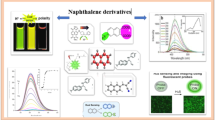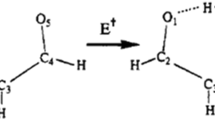Abstract
On the example of fluorescence quenching of perylene by organic electron acceptors we have shown that the radius of the quenching sphere depends on the electron affinity of the oxidizing agent. The deactivation of excited molecules of m-dinitrobenzene was achieved by tunnel electron transfer at a distance, which was significantly greater than the sum of the radii of the reagent molecules. The fluorescence quenching with phthalic anhydride, a weaker electron acceptor, occurs on contact between molecules. The kinetics of this process are described by the Smoluchowski theory of diffusion-controlled reactions. The rate of fluorescence quenching with carbon tetrachloride and nitromethane in polar solvents also increases with the increase of the coefficients of mutual diffusion, but the formal reaction radii of these processes are smaller than the sum of the radii of the interacting particles, which is due to the stereospecifity of the reaction. It was shown that the degree of stereospecificity increases with the decrease of the reaction radius.
Similar content being viewed by others
Literature cited
D. Rehm and A. Weller, “Kinetik und Mechanismus der Elektronubertragung bei der Fluoreszenzloschung in Acetonitril,” Ber. Bunsenges. Phys. Chem., 73, No. 6, 834–836 (1969).
A. Weissberger, E. Proskauer, J. Riddick, and E. Tups, Organic Solvents [Russian translation] Izd. Inostr. Lit., Moscow (1958).
R. Reid and T. Sherwood, The Properties of Gases and Liquids, McGraw-Hill, New York (1966).
E. D. Katz and R. P. W. Scott, “Use of chromatographic data to determine the molecular weight of a solute from a liquid chromatographic column,” J. Chromatogr., 270, No. 1, 29–50 (1983).
B. Sveshnikoff, “The quenching of fluorescence of dye solutions by foreign substances,” Acta. Physicochim. USSR, 4, No. 3, 453–470 (1936).
N. M. Émanuél and G. B. Sergeev (eds.), Experimental Methods of Chemical Kinetics, Vyssh. Shk., Moscow (1980).
N. B. Jurinski and P. A. D. de Maine, “Charge-transfer complexes in solution. 1. Spectrophotometric studies of aromatic hydrocarbon aromatic nitro compounds dissolved in carbon tetrachloride,” J. Am. Chem. Soc., 86, No. 16, 3217–3221 (1964).
B. Dale, R. Foster, and D. L. Hammick, “Interaction of polynitro compounds with aromatic hydrocarbons and bases. 13. The effect of charging of nitro compound,” J. Chem. Soc., No. 11, 3986–3990 (1954).
E. I. Kapinus, I. Yu. Kucherova, and I. I. Dilung, “Influence of the solvent on the quenching of the fluorescence of aromatic compounds by electron acceptors,” Teor. Eksp. Khim., 18, No. 5, 572–579 (1982).
E. I. Kapinus, I. Yu. Kucherova, V. P., Staryi, and I. I. Dilung, “Role of long-range elec tron transfer in excited molecule quenching,” Dokl. Akad. Nauk SSSR, 279, No. 4, 920–924 (1984).
S. Strauch, G. McLendon, M. McGüire, and T. Guarr, “Distances dependence of photoinduced electron transfer: Time-resolved electron transfer emission quenching in rigid solution,” J. Phys. Chem., 87, No. 19, 3579–3581 (1983).
H. Eyring, S. H. Lin, and S. M. Lin, Basic Chemical Kinetics, Wiley-Interscience, New York (1980).
J. R. Miller, J. V. Beitz, and R. K. Huddleston, “Effect of free energy on rates of electron transfer between molecules,” J. Am. Chem. Soc., 106, No. 18, 5057–5067 (1984).
J. K. Andre, M. Bouchy, and W. R. Ware, “Kinetics of partly diffusion-controlled reactions. 2. Competition between physical and chemical kinetics. Theoretical treatment,” Chem. Phys., 37, No. 1, 103–117 (1979).
N. Sutin, “Nuclear, electronic, and frequency factors in electron transfer reactions,” Acc. Chem. Res., 15, No. 9, 275–282 (1982).
E. I. Kapinus and V. P. Staryi, “The solvent effect on the kinetics of the deactivation of triplet electron acceptors,” Teor. Eksp. Khim., 17, No. 1, 35–43 (1981).
I. V. Khudyakov and B. I. Yakobson, “Effect of solvent viscosity on the cage effect,” Zh. Obshch. Khim., 54, No. 1, 3–23 (1984).
Author information
Authors and Affiliations
Additional information
Translated from Teoreticheskaya i Éksperimental'naya Khimiya, Vol. 22, No. 5, pp. 585–590, September–October, 1986.
Rights and permissions
About this article
Cite this article
Kapinus, E.I., Dilung, I.I., Kucherova, I.Y. et al. Stereospecificity of quenching of excited aromatic molecules by electron acceptors. Theor Exp Chem 22, 558–563 (1987). https://doi.org/10.1007/BF00522541
Received:
Issue Date:
DOI: https://doi.org/10.1007/BF00522541




